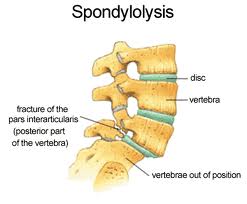Spondylolisthesis: Back Condition And Treatment
Spondylolisthesis refers to the slipping of part or all of one vertebra forward on another. The term is derived from the Greek spondylos, meaning vertebra and olisthanein, meaning to slip or slide down a slippery path.
It is often associated with bilateral pars defects that usually develop in early childhood and have a definite family predisposition. Pars defects that develop due to athletic activity (stress fractures) rarely result in spondylolisthesis.
Spondylolisthesis is most commonly seen in children between the ages of 9 and 14, in the vast majority of cases it is the LS vertebra that slips forward on the S1. The spondylolisthesis is graded according to the degree of slip of the vertebra. A grade I slip denotes that a vertebra has slipped up to 25% over the body of the vertebra underlying it; in a grade II slip the displacement is greater than 25%; in a grade III slip, greater than 50%; and in a grade IV slip, greater than 75%. Lateral X-rays best demonstrate the extent of vertebral slippage.
Clinical Features
Grade I spondylolisthesis is often asymptomatic and the patients may be unaware of the defect. Patients with grade II or higher slips may complain of low back pain, with or without leg pain. The back pain is aggravated by extension activities.
On examination, there may be a palpable dip corresponding to the slip. Associated soft tissue abnormalities may be present. In considering the treatment of this condition, it is important to remember that the patient’s low back pain is not necessarily being caused by the spondylolisthesis.
Treatment
Treatment of athletes with grade I or grade II symptomatic spondylolisthesis involves:
- Rest from aggravating activities combined with abdominal and extensor stabilizing exercises and hamstring stretching.
- Antilordotic bracing, which may also be helpful.
- Mobilization of stiff joints above or below the slip on clinical assessment; gentle rotations may be helpful in reducing pain; manipulation should not be performed at the level of the slip.
- Athletes with grade I or grade II spondylolisthesis may return to sport after treatment when they are pain free on extension and have good spinal stabilization.
- If the symptoms recur, activity must be ceased.
- Athletes with grade III or grade IV spondylolisthesis should avoid high speed or contact sports.
- Treatment is symptomatic. It is rare for a slip to progress; however, if there is evidence of progression, spinal fusion should be performed.
If you are being impacted in low back pain again then come instantly at Alliance Physical Therapy Center in VA & DC. Our Reduced Lower back Program uses a consistent, functional and outcomes-oriented approach to care that concentrates specifically on the lower back. Through an active and educational procession of treatment, our practitioners assist the affected person in returning to normal, activities as soon as possible. By providing comprehensive education in structure, pathology and proper proper the lower back, the affected person is motivated to participate in his or her recovery and in the prevention of future injury. For more information Call Now at: 703-205-1919
